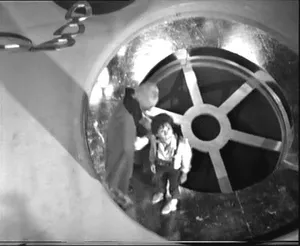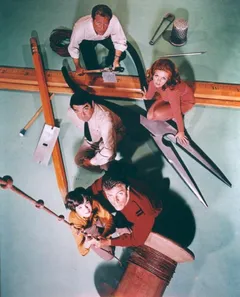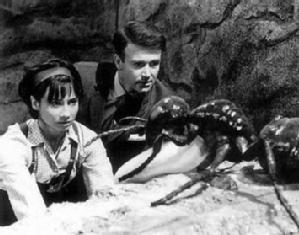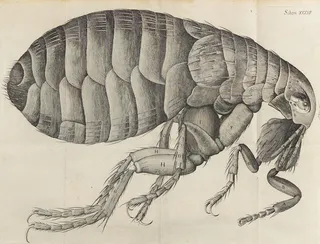The Incredible Shrinking Man
A frequently used plot device in science fiction is miniaturisation. The visual imagery of humans struggling with everyday objects many times their own size, or encountering usually benign animals as terrifying monsters, captures the imagination. More generally, as well as providing entertaining adventure, tales of miniaturised humans place the (often male) protagonists in a submissive and vulnerable role which contrasts with their normal roles in fiction and encourages the audience to reflect on their own smallness in the grand scheme of things.
The first class of science fiction stories to address miniaturisation invokes exaggerated biological processes, whether triggered through the action of hormones or radiation.
An example of the relatively rare former option is Dr Grimshaw’s Sanitorium (Pratt 1934), which takes the principle of dwarfism to an illogical extreme. Here an amoral medical scientist experiments on the glands of rehab patients, eventually reducing characters to the size of mice… and leaving them at the mercy of a cat. The logic here is that growth is sometimes regulated by the pituitary gland and affected by hormones. However restricted growth in nature can be either genetic or a developmental disorder - either way, treating adults with hormones cannot reverse growth that has already occurred, let alone have such extreme effects. While the published story reads primarily as a reflection on the narcotic dope trade and unregulated medication, its 1955 radio adaptation in the X-minus-One anthology series recasts the villains of the piece as ex-Nazi doctors on the run from war crimes investigators. Either way, the underlying theme is one of distrust of novel medical practice, a theme which remains regrettably recognisable almost a century later.
The post-war period also saw a number of examples in which (rather than dying horribly) individuals exposed to radiation underwent extraordinary transformations. In this context, The Incredible Shrinking Man (film, 1957) and The Atom (comic, first appeared 1961) are notable examples of miniaturisation triggered by uncontrolled radioactivity exposure. It need hardly be said that no known effect of ionizing radiation would cause contraction of healthy tissue.
In each case here, the actual mechanism for miniaturisation remains unclear, and it’s fair to say that all are contradicted given the known laws of biology and physics.
 A second category of miniaturisation story in SF features the deliberate reduction of size through technology. Notable examples here include the Century 21 films television series The Secret Service (1969, in which a suitcase-sized device miniaturises a secret agent who then works with an elderly vicar) and the feature films Fantastic Voyage (1966) and Honey, I Shrunk the Kids (1989). In the first of these films, a crew is miniaturised in a rigorously scientific operation in order to perform internal microsurgery on a VIP. In the second, a stereotypical mad inventor comes up with a Heath Robinson contraption which miniaturises his children accidentally. Despite the very different approaches - with po-faced science contrasting with children’s adventure and goofy comedy - the simple fact is that all of these miniaturising rays are equally implausible.
A second category of miniaturisation story in SF features the deliberate reduction of size through technology. Notable examples here include the Century 21 films television series The Secret Service (1969, in which a suitcase-sized device miniaturises a secret agent who then works with an elderly vicar) and the feature films Fantastic Voyage (1966) and Honey, I Shrunk the Kids (1989). In the first of these films, a crew is miniaturised in a rigorously scientific operation in order to perform internal microsurgery on a VIP. In the second, a stereotypical mad inventor comes up with a Heath Robinson contraption which miniaturises his children accidentally. Despite the very different approaches - with po-faced science contrasting with children’s adventure and goofy comedy - the simple fact is that all of these miniaturising rays are equally implausible.
The basic problem is that miniaturising a person requires either compression of existing matter into a smaller space, or somehow reducing the scale of that matter. With compression, any technology faces the problem of overcoming the fundamental forces which set the size of molecules, atoms and ultimately cells - notably the uncertainty principle. There are also rather severe practical difficulties to be faced. A 10cm tall, 100kg human would also exert enough force to shatter any surface it walked across. With reduction in size (and presumably mass) of particles, rather than compression to a higher density, technology comes up against issues of conservation of mass and energy, with mass, charges and forces all needing to be scaled in proportion. Whichever approach is taken, the miniaturised individual would be unable to breath normal-sized air molecules, move through the relatively much thicker air, or even see (since smaller eyes would not focus or detect visible light wavelengths correctly). What’s more, without a better understanding of how memories are stored and personality related to neurological activity, there cannot be any logical process proposed to reduce neural volume and charge while keeping an individual’s mind and mental complexity intact.
Indeed, SF writer Isaac Asimov, who wrote the novelisation of Fantastic Voyage, made no bones about the implausibility of the scenario. While he adopted the “every atom had been miniaturised” scenario, he noted in his introduction to the novel that every known physical law prevented the plot from making sense.
He did, however, himself select a miniaturisation short story - Surface Tension [1] by James Blish (1952) - to discuss in his anthology of scientifically-interesting SF stories Where do we go from here? (ed. Asimov 1973). In this story a biological seeding ship from Earth microengineers a race of human-intellected individuals just 25 microns in size and occupying an aquatic environment (through never-explained means). The resulting life forms must compete with microfauna and eventually face the challenge of escaping from the water, despite being held back by surface tension - the same property which allows insects to skim the surface of ponds, and acts as a near-insurmountable wall of force to organisms so small. Indeed Asimov provided a commentary which noted with interest that having made the one impossible assumption (miniaturisation) Blish excelled in his effort to ensure plausibility in exploring its consequences. In particular this story is notable for seriously considering the problem of interacting with liquids at microscopic scales.
So are there any scenarios where science fiction involving miniaturisation, if not exactly plausible, is not entirely barred by known physical laws?
 Well, one distant possibility might involve modifying space-time itself, rather than the physical nature of individuals within it. This is the approach seen, for example, in Doctor Who. Both the 1964 story "Planet of the Giants" (see image) and 2014’s "Flatline" involve malfunctions to the TARDIS which result in miniaturisation [2]. Since this alien craft modifies space-time dimensionality in its interior, its passengers can be altered in scale relative to their surroundings, and the ship is also known to exert an influence outside its own walls. Again, this does not actually explain the physics involved, or how the miniaturised individuals continue to breathe or see, but it does at least explain why atomic bonds and other physical properties are not destroyed; the bonds operate on the same scale as normal in a local space-time bubble which just differs from its surroundings. Particularly in the case of "Planet of the Giants" the contrast between human-sized characters and every day objects provides an eye-catching image which somewhat makes up for the incoherent explanations.
Well, one distant possibility might involve modifying space-time itself, rather than the physical nature of individuals within it. This is the approach seen, for example, in Doctor Who. Both the 1964 story "Planet of the Giants" (see image) and 2014’s "Flatline" involve malfunctions to the TARDIS which result in miniaturisation [2]. Since this alien craft modifies space-time dimensionality in its interior, its passengers can be altered in scale relative to their surroundings, and the ship is also known to exert an influence outside its own walls. Again, this does not actually explain the physics involved, or how the miniaturised individuals continue to breathe or see, but it does at least explain why atomic bonds and other physical properties are not destroyed; the bonds operate on the same scale as normal in a local space-time bubble which just differs from its surroundings. Particularly in the case of "Planet of the Giants" the contrast between human-sized characters and every day objects provides an eye-catching image which somewhat makes up for the incoherent explanations.

A similar although less controlled space-time disturbance was responsible for displacing the sub-orbital shuttle Spindrift and its passengers that feature in Land of the Giants (TV, 1968-70) and may be in part to blame for their size change. To all appearances the stranded crew experiences time and gravity unaffected by their passage through the displacement. They are simply shrunken. However in this case the space-time distortion would appear to be transient and localised (unlike the constantly-active TARDIS). It's not clear, then, why the effects of such a distortion would persist indefinitely. The interpretation is complicated further by a number of episodes in which characters are either expanded to giant size or shrunk to human size, through a variety of drugs, rays and other treatments.
The alternate explanation - that the animals, plants, residents and other natural and geological features of the planet the shuttle Spindrift crashed onto are instead supersized - is also adopted in the 1973 French-language film Le Planet Sauvage. Here humans exist as vermin in the walls and gardens of the huge homes of an alien race. However this proposed giantism faces many of the same issues as miniaturisation. The physical scale of many objects on Earth is set by a combination of gravity and the tensile strength of materials - it is unlikely that balances of forces, muscle strength and bone structure would make a giant human (or its associated ecosystem, materials or geology) any more practical than a miniaturised one. A giant-sized humanoid would be vulnerable to limbs broken by minor bumps or falls and its heart might struggle to pump blood to its lofty brain.
However, even if these cases remain ambiguous, space-time distortions are certainly responsible for the miniaturisation of some humans living in extreme environments in SF. An example here (that I’ve not had a chance to read yet myself) is the novel Flux (Stephen Baxter, 1993), in which a human civilisation on a neutron star is reduced to microscopic sizes by the enormous gravity. In such a strong field, time as well as length becomes distorted, leading to very different experienced timescales for the differently-sized culture.
If miniaturisation has always been so implausible (short of invoking neutron star gravities), then, why is it such a popular theme in science fiction?
Well, arguably, the history of technology over the twentieth and twenty-first century has been a history of miniaturisation - vehicles, home appliances such as televisions, computers and other equipment, have gradually become more compact (or occasionally more powerful for the same size) [3]. As a result, miniaturisation became a symbol of modernity and futurism, whether applied to technology or organic life.
A valid question to be asked, though, is whether much of the work in this area is science fiction at all, or simply semi-disguised fantasy. Indeed some of the earliest speculative fiction in this genre, including Gulliver’s Travels (Swift, 1726) and the adventures of Tom Thumb (a character in English folklore) did not concern itself with technology or science at all. Stories of “little people” interacting with humanity date back at least to medieval times and come down to the near-present in examples such as Terry Prattchett’s Nome Trilogy (1989-90) and The Borrowers (Norton, 1952). Indeed, even when framed as SF, part of the attraction may be that miniaturisation is so far from plausibility that Clarke’s Third Law can be applied - any technology involved is indistinguishable from magic and the focus can sit on the characters and plot rather than the mechanism.

As I hinted above, the protagonists of these stories are often (although not always) men, and there is perhaps room for gendered readings of some examples - the men are either forced to come to terms with (and triumph over) an unaccustomed impotence, are shown as literal “little” men unable to deal with their situation, or are given opportunity to exhibit their masculinity in combat against the “monsters” of a miniaturised world. Indeed, the television series Land of the Giants in particular provides good examples of all these reactions. Ultimately, the audience appeal here falls back on some of the earliest gendered roles, with the male members of the stranded crew taking on the role of hunters while the women and child gather. Nonetheless, they are frequently forced to admit their impotence and frustration when directly confronting the giants. Such plots can be compelling when well handled, speaking to insecurities and interest in the human condition.
A related invocation of vulnerability, this time less gendered in nature, appears in examples where miniaturisation forces human protagonists to face the same threats as animal life deals with daily in our own world. By placing humans in such a situation, and focussing on their reactions to threats they would never have thought twice about at normal size, questions are asked about the morality of our own treatment of the Earth's flora and fauna. A good example here is Doctor Who's "Planet of the Giants" (mentioned above) in which the insect-sized TARDIS crew encounter insects and other life that has been wiped out by pesticides. This story was inspired by the nascent environmental movement of the time, and its portrayal of poisoning and animal death is strikingly macabre.
Another motivation for writing about miniaturisation which we shouldn't overlook, is that it's simply very good fun. There is an intrinsic humour to the juxtaposition of the familiar with the unexpected. Many examples of miniaturisation, such as Honey, I Shrunk the Kids, The Secret Service, and even Gulliver’s Travels, find humour in the interaction of miniature people with a full-sized world (and occasionally vice versa) - for example the use of a paperclip as a weapon or an egg-cup as a vehicle. Such humour provides a hook for the audience, drawing them in so that more serious or complex ideas can be discussed.

Finally, perhaps, miniaturisation speaks to the fascination many people find in learning about the microscopic world and discovering unfamiliar aspects of our everyday lives. First published in 1665, Robert Hooke’s Micrographia became a best seller and alerted the public to the idea that a drop of water could contain a zoo. Under magnification, a near-invisible flea could be seen as an armoured monstrosity… and that kind of observation has drawn generations of children into classroom investigation of pondwater, the investigation of ant farms, or other microfauna. Arguably modern science fiction, particularly in visual media, is continuing in Hooke’s tradition, bringing the public to a broader and more detailed understanding of the world in which we live.
“The Incredible Shrinking Man”, Elizabeth Stanway, Cosmic Stories blog, 14th November 2021.
[1] “Surface tension” was also adapted as a half-hour radio drama by NBC anthology series X-Minus-One in 1956. The adaptation, written by George Lefferts and directed by Scott Buckley, changed a number of plot elements, including the prologue which motivates the miniaturisation, and also introduced a number of astronomical inaccuracies, but is still entertaining. [Back to text]
[2] Also worth noting in the context of Doctor Who is the Master's "tissue compression eliminator" - a weapon that dealt simultaneously with the problem of killing people and disposing of their bodies by miniaturising them to doll-size. Here there was no attempt to pretend that this process was survivable, but the failure to conserve mass remains a problem - the miniaturised victims could be easily lifted in one hand. Presumably (to play with an in-universe retcon explanation) as a Time Lord, the Master was able to draw upon TARDIS technology in designing his weapon. [Back to text]
[3] Anecdotally, some manufacturers of early mobile phones thought their use as a status symbol amongst businessmen would create pressure for large phones (a reasoning that's hard to interpret as anything but phallocentric), and were taken by surprise when instead the smallest phones proved the most popular and highest in status. [Back to text]
